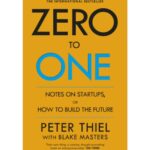LISTEN NOW
Outline of Zero to One by Peter Thiel
Outline
Expand to Read ...
1. Introduction
- Core Idea: Innovation, the creation of “zero to one” moments, is essential for economic profit and human progress.
- Concepts:
- Zero to One: Creating something entirely new (e.g., the first product of its kind).
- One to n: Replicating or improving existing products incrementally.
- Argument: Technology is in a state of stagnation; many companies focus on replication instead of innovation.
- Premise: Without new technologies, businesses fail, and global progress stalls.
2. The Challenge of the Future
- Future Shaped by Technology, Not Globalization:
- Vertical Progress: Innovation that leads to unprecedented advances (0 to 1).
- Horizontal Progress: Globalization and replication of successful models (1 to n).
- Key Insight: Globalization without innovation is unsustainable due to resource limitations and environmental impacts.
3. Startup Thinking
- Startups as Innovation Engines:
- Startups are small, flexible, and cohesive, enabling original thinking.
- Larger organizations are risk-averse, and solo innovators lack resources to establish new industries.
- Thiel’s Perspective: Startups require contrarian thinking and must redefine their industries to succeed.
4. The Contrarian Question
- Key Question: “What significant truth have you uncovered that others overlook?”
- Method:
- Identify prevailing beliefs.
- Consider their antithesis, which often holds more truth.
- Example: Lessons from the dot-com crash:
- Misguided ideas (e.g., focus only on short-term gains, modest improvements) stifle innovation.
- Thiel argues for ambitious visions, long-term strategies, and market creation instead of competition.
5. Misconceptions About Competition and Monopoly
- Perfect Competition vs. Monopoly:
- Perfect Competition: Numerous suppliers lead to zero profit margins.
- Monopoly: Market dominance enables long-term profitability.
- Monopolies as Drivers of Progress:
- Creative monopolies benefit society through innovation and improved products.
- Example: Temporary monopolies like those formed by patents incentivize innovation.
- Critique of Competition:
- Competition diverts focus from innovation to resource duplication and internal conflicts.
6. Preparing for Future Profits
- Key Attributes of a Successful Monopoly:
- Proprietary Technology: Must offer unique and substantial advancements.
- Network Effects: Product value grows with user adoption.
- Economies of Scale: Cost per unit decreases as production scales.
- Branding: Strong, unmistakable identity.
- Strategic Guidelines:
- Start with small markets and gradually expand.
- Avoid direct competition with established firms.
- Leverage the first-mover advantage strategically.
7. The Power Law
- Definition: Exponential growth where the top 20% controls 80% of the value (Pareto Principle).
- Applications:
- Focus on high-impact opportunities (e.g., top startups, jobs, or fields of study).
- Avoid spreading resources thin across numerous ventures.
8. The Importance of Secrets
- Belief in Secrets: Revolutionary ideas and untapped opportunities exist.
- How to Find Secrets:
- Human Approach: Explore overlooked questions or problems.
- Natural Approach: Use observation and data to uncover trends.
9. Thiel’s Law: Building a Strong Team
- Importance of Early Decisions:
- Select co-founders carefully—this is the most critical decision.
- Create clear structures for equity, strategy, and operations.
- Key Hiring Principles:
- Hire passionate, full-time employees with well-defined roles.
- Align employee interests with long-term company goals via equity.
10. Sales and Distribution
- Critical Role of Marketing:
- Distribution strategy is as important as product development.
- Misconception: Advertising should not seek immediate sales but establish product presence.
- Sales Methods:
- Complex Sales: High-cost, CEO-driven (e.g., business-to-business deals).
- Direct Sales: Sales reps manage personal interactions for mid-value products.
- Mass Marketing: Effective for consumer products with high lifetime value.
- Viral Marketing: Low-cost, ideal for low-CLV products, leveraging user networks.
11. Humans vs. Computers
- Complementary Strengths:
- Humans excel at interpretation and value judgment.
- Computers handle large data processing and pattern recognition.
- Leveraging Complementary Capabilities:
- Example: Palantir software combines computer efficiency with human analytical insights.
12. Eccentric Founders
- Traits of Successful Entrepreneurs:
- Eccentricity and unconventional thinking correlate with innovative ideas.
- Notable Examples: Steve Jobs, Elon Musk, Howard Hughes.
- Paradox: Eccentricity fosters unique company identity but may hinder collaboration.
13. Four Views of the Future
- Perspectives on Technological Progress:
- Cyclical: Repeated rise and fall of technology.
- Doomsday: Maximum progress followed by collapse.
- Convergence: Global homogeneity as developing nations catch up.
- Acceleration: Continuous, exponential technological advancement (Thiel’s advocated view).
14. Checklist for Success
- Seven Essential Elements:
- Revolutionary technology.
- Unique insight.
- Monopoly status.
- Strategic timing.
- A skilled, mission-driven team.
- Effective distribution.
- Long-term value.
15. Case Study: Clean Tech Bubble
- Failures:
- Minor improvements, lack of strategic planning, and inadequate teams led to the collapse of many firms.
- Success Story: Tesla:
- Fulfilled all criteria, from innovative technology to effective distribution, ensuring long-term dominance in the electric vehicle market.
16. Conclusion
- Key Message: Innovation is essential for progress. Focus on creating revolutionary technologies, fostering strong teams, and planning for the long term.
- Call to Action: Actively pursue breakthroughs to shape a brighter future.

 Buy on Amazon
Buy on Amazon